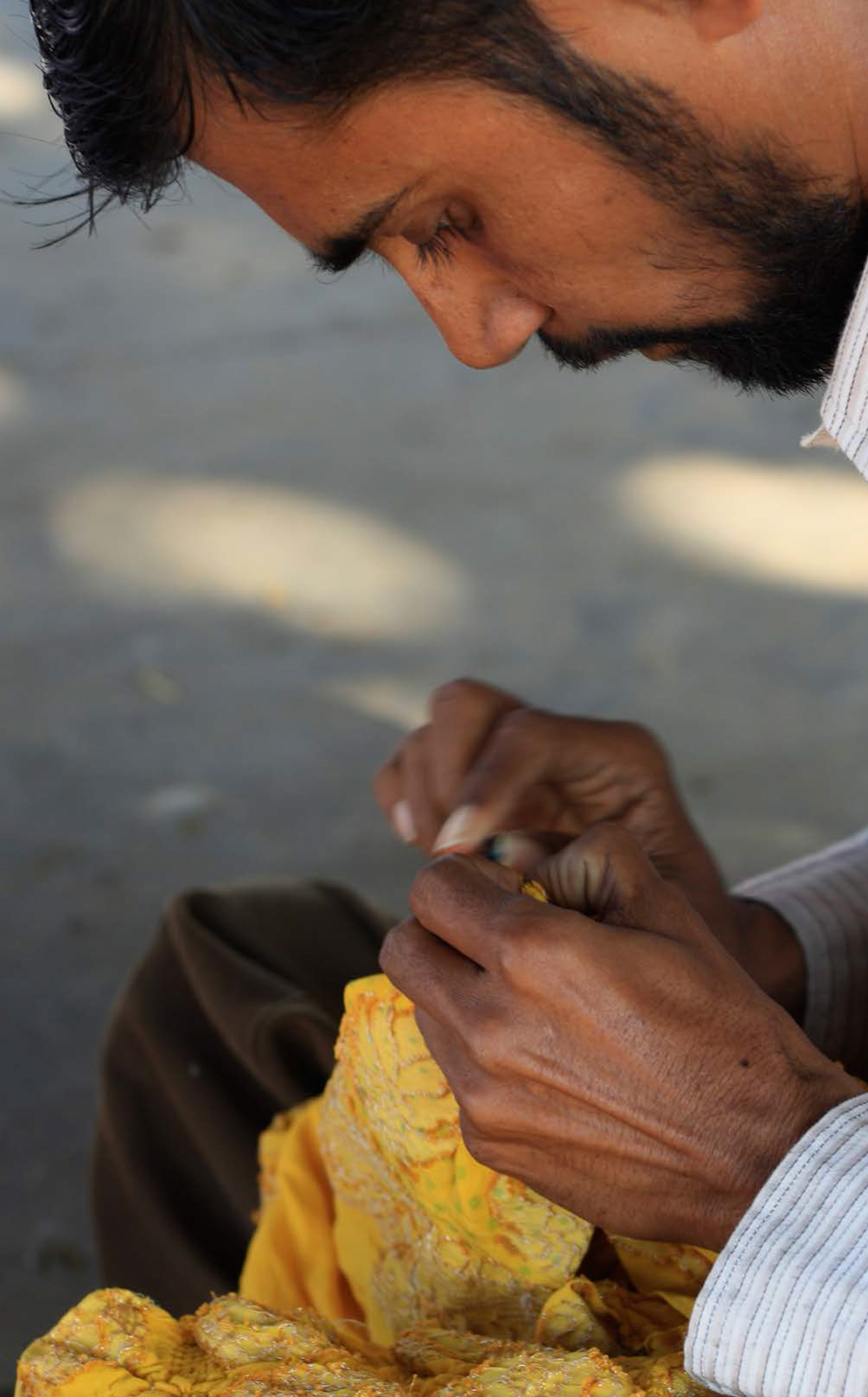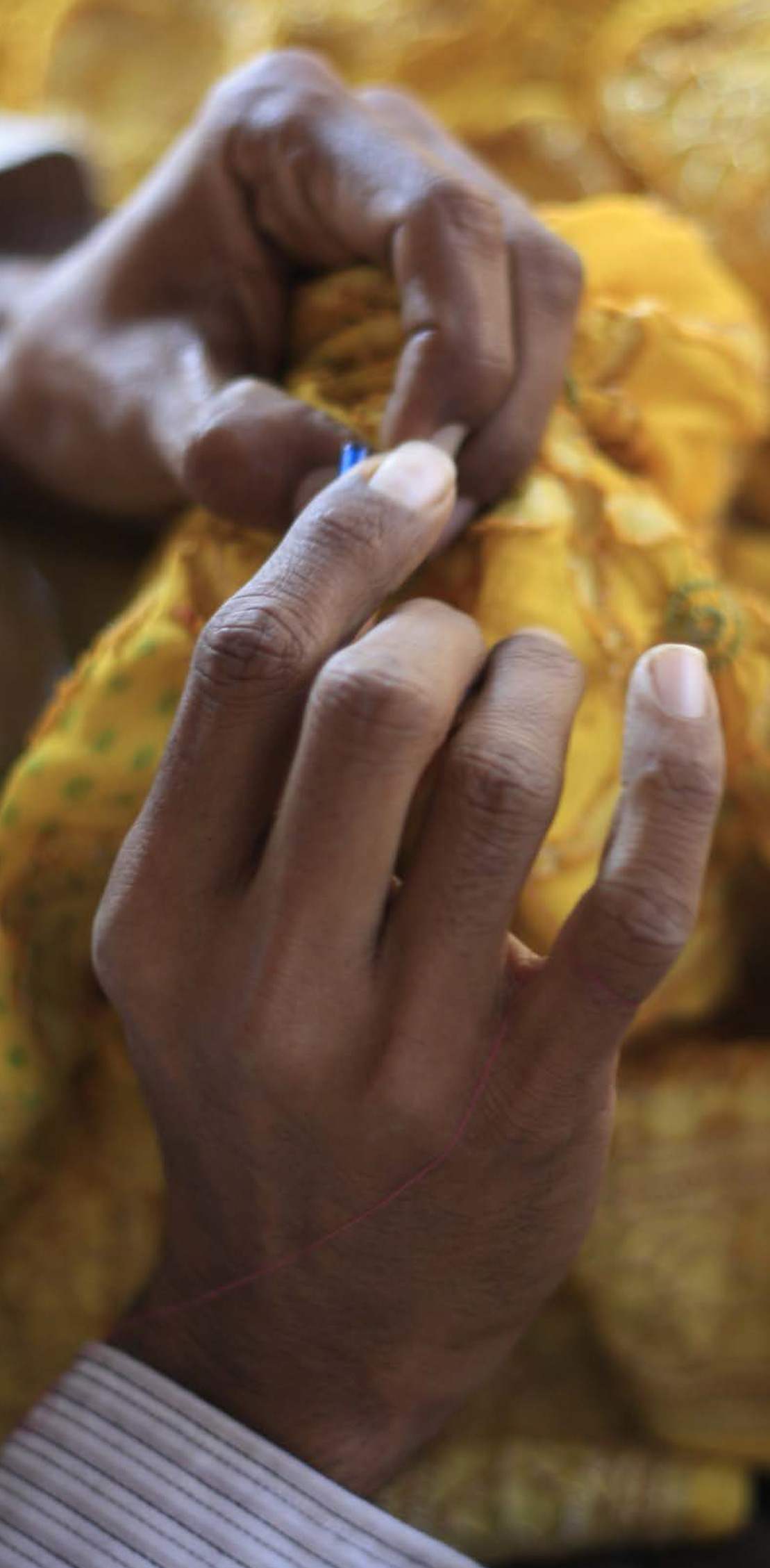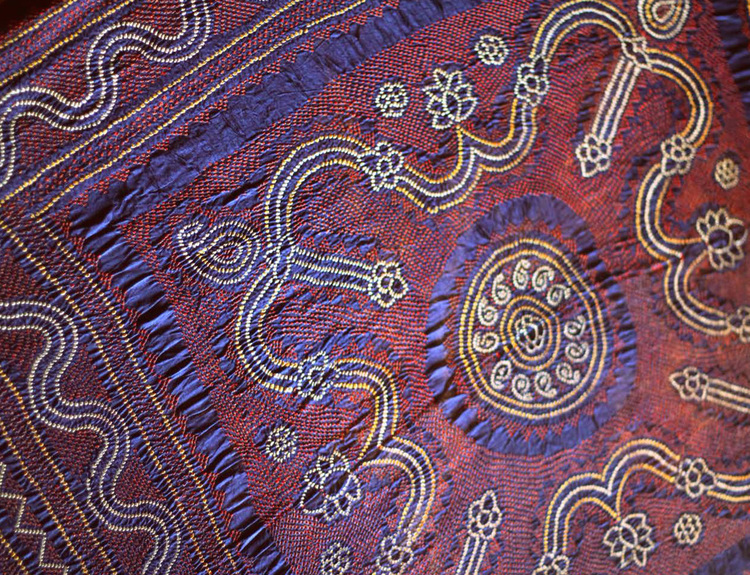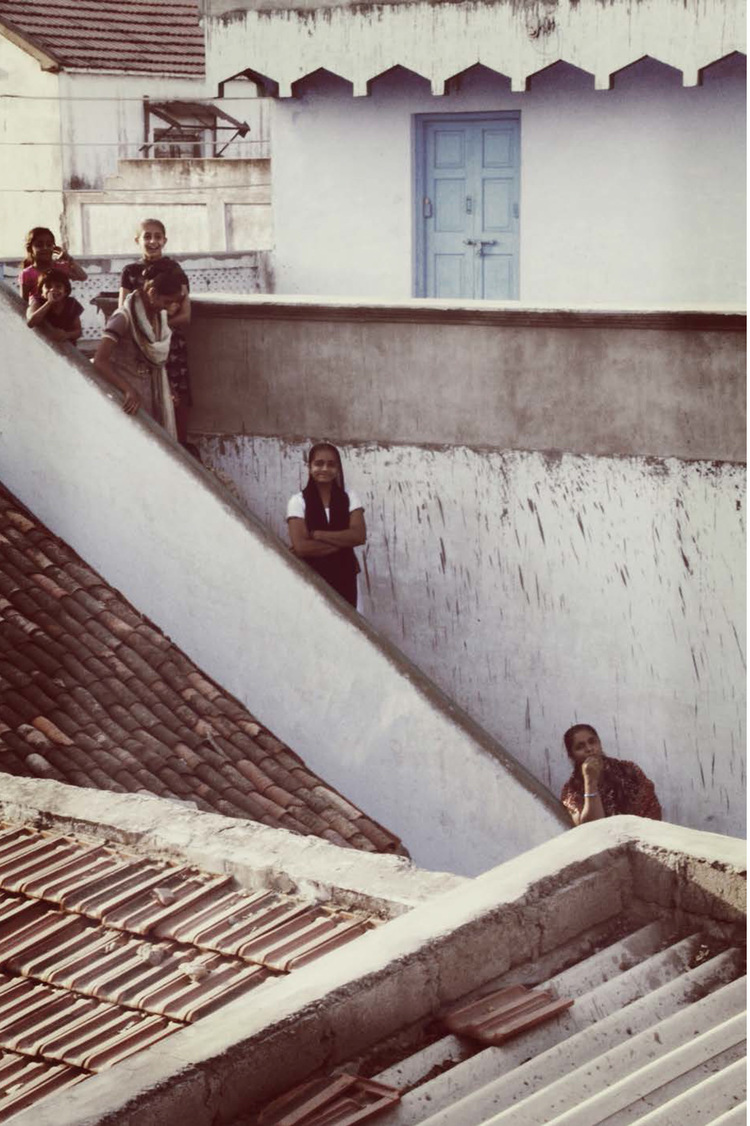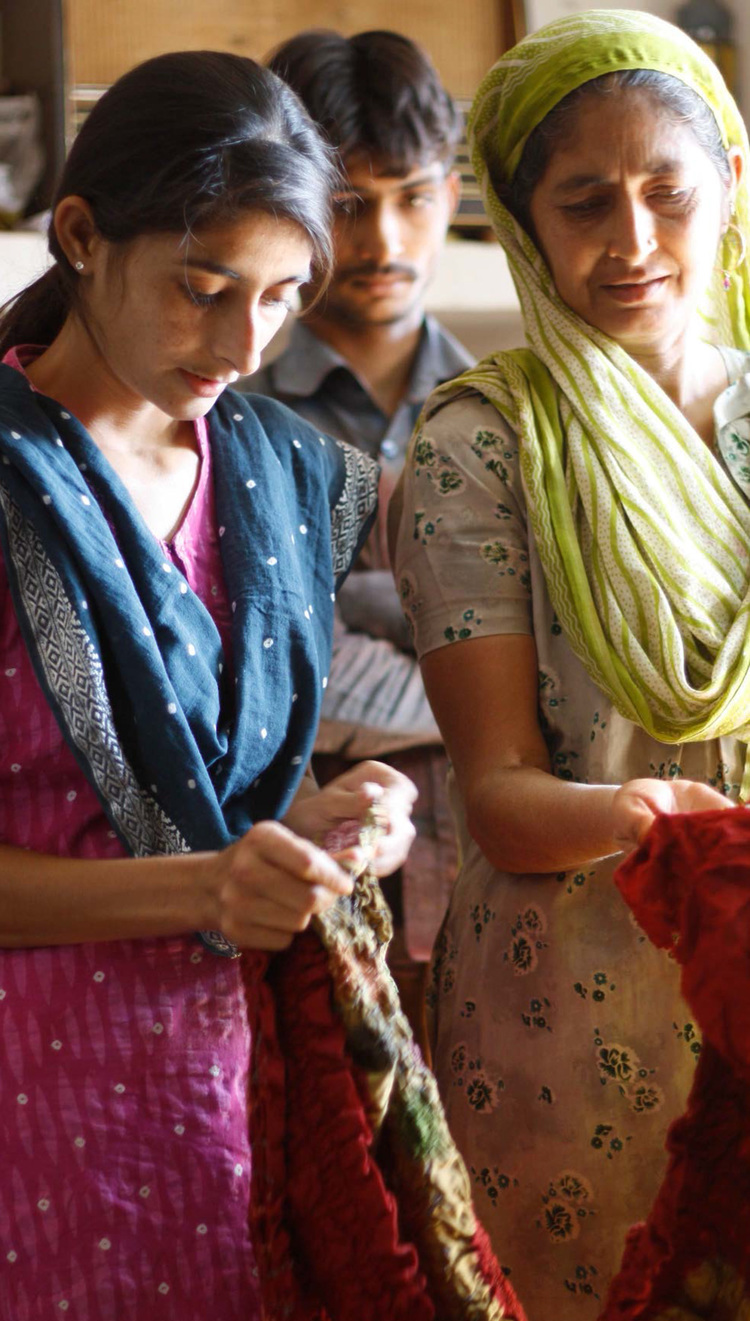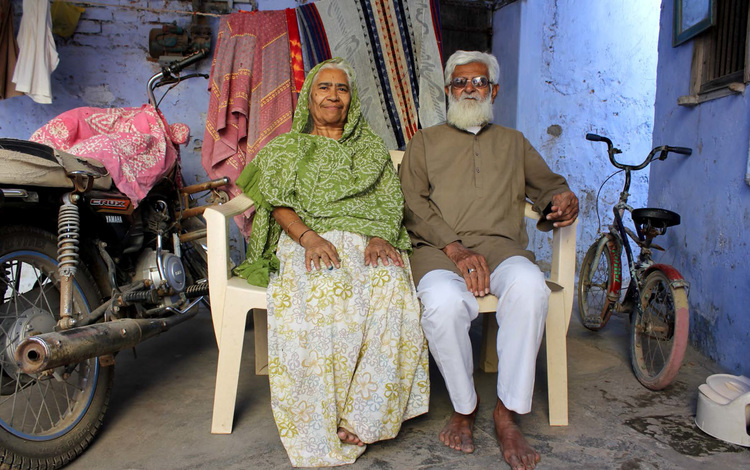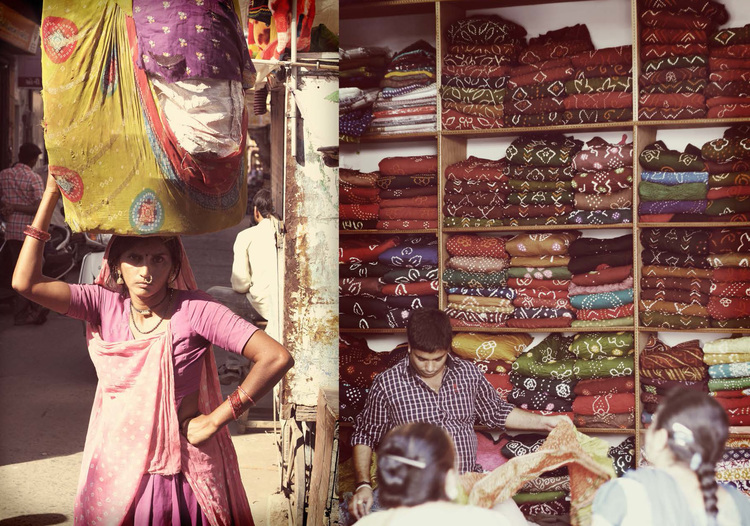Abdasa
Abdasa is known for the finest tying technique in all of Kachchh, and the silk bandhani saris and duppattas are coveted by many communities and businessmen. Artisans from all parts of Gujarat send or bring their pieces to be tied in Abdasa, where both men and women do the work. Bandhani production has significantly increased in the last 20-30 years.
Generally, artisans first deliver the raw material with the printed design to the women for circum bandhej. Next, the material is either sent to be dyed or directly to the men who specialize in bharti. The work in Tera village is considered to be the best, because the women have been practicing this craft for many generations. Accordingly, they earn better than their peers as their work is in high demand and well rewarded. Many ofAbdasa’s villages participate in bandhani production, including Tera, Bara, Naliya,
Spotlight on the artisans: Abdulaziz Soneji
“ There has been a shift from bandhani as a craft to a business: workers are not always interested in making the best pieces but want to earn their money. We have people who want to buy old pieces, but the ones to make them are not there anymore.”
Abdulaziz Soneji and his brothers come from a family of bandhani and discharge printing artisans, and have been working in different aspects of bandhani for more than 25 years. Abdulaziz has seen improvements and changes in his work, especially as printers and dyers like his brother moved to Bhuj. The majority of Abdasa’s artisans only work with the tying process of bandhani, and businessmen travel here from across Kachchh, Gujarat and India to get their pieces tied here. Abdulaziz currently hires about 400- 500 people, both men and women from villages all over the region. In Tera, the relaxed atmosphere lends itself to tiers working for many hours a day, and the demand for artisans of their calibre is only increasing.
One of Abdulaziz's oldest clients is Kishore Poladia, owner of Jyoti Sari Emporium in Mumbai, who has been running his shop for more than 35 years. Many Mumbai businessmen come to Kachchh to get their saris tied, with the dyeing taking place elsewhere. Jyoti Sari Emporium used to cater to only Gujaratis in Mumbai, but Maharashtrian women have also joined the store's clientele, purchasing saris ranging from Rs. 5,000 to Rs. 50,000.
Mr. Poladia comes to Abdasa often to visit Abdulaziz in his home and check on his orders. As these visits tend to happen at home instead of a shop, the artisan-businessmen relationship becomes more personal in nature. This relationship also forms between women tiers and the artisans they work for, as everything is done through home visits. All parties involved in this chain work hard to maintain and strengthen their relationships
Spotlight on the artisans: Bharti Vishrambhai Yadav
Bharti Vishrambhai Yadav has been tying since she was 1 4 years old, when she learned how to tie from her mother. It took her one year to learn it properly, but now she is an expert and is training her sister. She started by tying big dots on cotton bandhani, and slowly moved on to thinner fabrics and finer dots. Tiers almost never get to see the final product and only wear cheaper bandhani fabrics from the market.
Bharti enjoys her work, has good relationships with Khatris, and can earn upto Rs 2,000 per sari, which is equal to tying 48,000 dots or 12,000 kadis (unit for counting ties). Many women in her village tie bandhani for 2-3 hours a day and earn well without having to leave their house or neglecting their housework. Some women tie for an income while others tie for spending money, or for fun. Bharti is now back in school, but will resume her work as soon as her studies are completed.
“Bandhani is an art. I feel comfortable doing it and I enjoy it. Before, when women were first trained to do bandhani, they did not get paid so well, but now, we know what we deserve and we make sure we receive that.
Artisans make 4 times as much as we do, so sometimes I feel that it would be good if I could do all this on my own.”
Spotlight on the artisans: Rahim Abdul
Rahim Abdul comes from the Kumbhar (potter) community in Tera, and has been tying bandhani for many years. He learned it because of his friends, and specializes in bharti bandhej . Bandhani is an old profession, and only Khatri’s sons knew how to tie, but now, men from so many communities are earning a livelihood from this profession. If they are really good, they could earn upto 500 rupees a day, and generally make more money as they get faster with practice.
"Bandhani is an art, it is working with your hands. We tie without any designs and after the garment has been dyed and opened, it looks beautiful."
Spotlight on the artisans: Rafiq Alimohamed Khatri
Rafiq Alimohamed Khatri is one of a few families involved with bandhani in Naliya, and had started his career as a printer in Bhuj. After 8 years, he started his own business of tying in Abdasa. His main clients are businessmen from Surat and Mumbai, and many of them have been working with him from the beginning. Rafiq spends most of his time going from house to house distributing, checking and picking up garments, especially since his tiers are in high demand and do not like waiting for more work to reach them. He also travels to Bhuj frequently as the printing and dyeing for his saris happens there. In Naliya, there are at least 300-350 tiers, and many more in all 132 villages in Abdasa. His work is seasonal as many of the women that work for him come from farming families, and recently, many men who used to work for him have taken up jobs in companies.
“I can recognize one of my pieces if I see it. I saw one of my saris on a TV serial I was watching at home. This work has been blessed by God, it is so old and seeing the way it is now, I don’t think it will ever reduce. It will only increase.”
Explore other regions:



